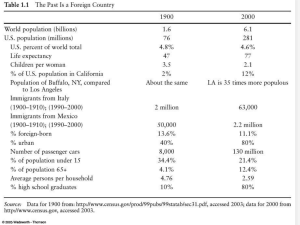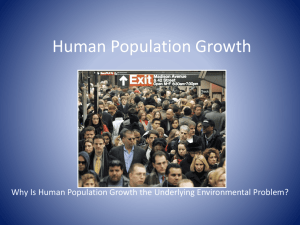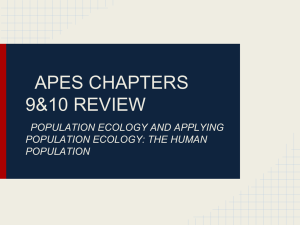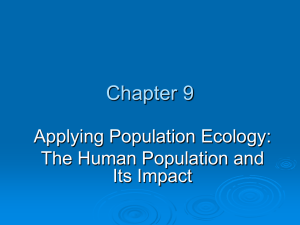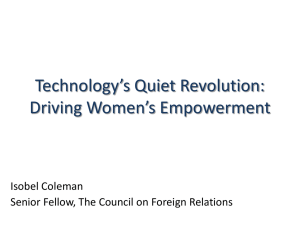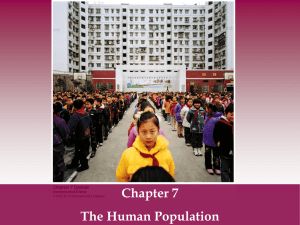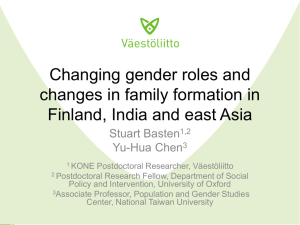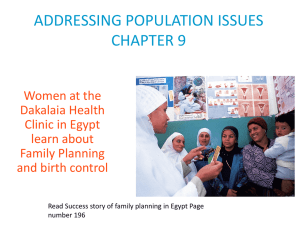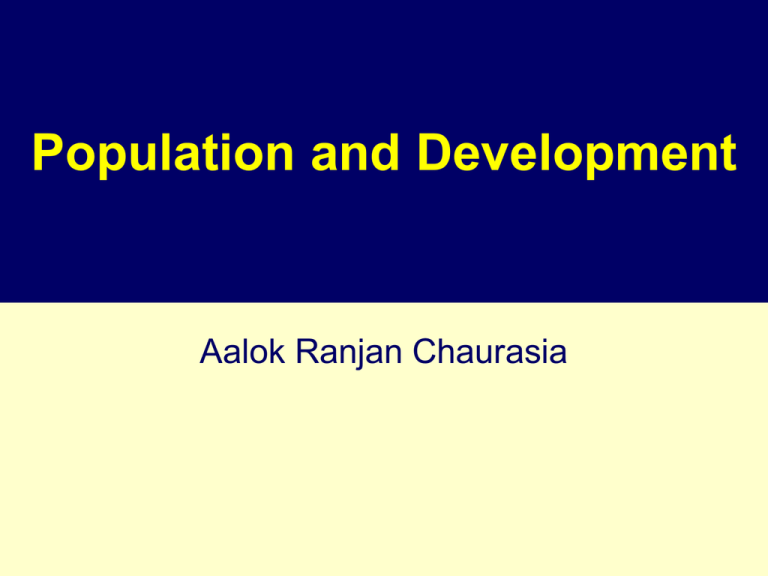
Population and Development
Aalok Ranjan Chaurasia
The Context
• All development is for the people
• People are the ultimate and the only
beneficiaries.
• Development is directed towards meeting the
needs the people.
• Development also contributes to capacity
building of individuals as well as group of
individuals –family, society, etc.
2
The Context
• Development needs of the people are not the
same.
• They vary by basic characteristics of population
– Size, Age, Sex
• The population stock determines the
development needs.
• Development modifies the population stock
through changes in mortality, fertility and other
determinants.
3
Outline of Presentation
• Historical thinking about population as it affects
social and economic progress.
• Population, natural resources and environment.
• Age structure transition.
• Dynamics of population growth.
• Population and development integration.
• Population and development integration in
India.
4
Historical Perspective
• Population and development debate dates back
to times immemorial.
– Chinese philosophers, Confucius and others.
• Ideal proportion between land and population.
• Checks to population growth.
– Greek philosophers, Plato and Aristotle.
• Optimum population with respect to Greek city state.
• Ideal conditions for full development of man’s potential.
– Romans viewed population in the context of great
empire.
5
Historical Perspective
– Hebrew sacred books placed a strong emphasis on
procreation and multiplication.
– Kautilya, in his Arthashastra, dating back to 3-4
Centuries BC, has dealt in detail about the role of
population in building a great empire.
– During 15-18 Centuries, the view emerged that
‘resources determine population.
• Botero, Sir Walter Raleigh
– “Increase resources availability” was the basic
paradigm of development.
6
Malthus
•
•
•
•
•
Subsistence severely limits population-level
When means of subsistence increase, population
increases
Population-pressures stimulate increase in
productivity
Increase in productivity stimulates further populationgrowth
Since productivity can not keep up with the potential
of population growth for long, population requires
strong checks to keep it in line with carryingcapacity.
7
Malthus
• Two kinds of checks that limit the growth of
population
– Preventive checks. These checks lead to a
reduction in the birth rate – moral restraints, birth
control and vice.
– Positive checks. These checks lead to an increase
in the death rate – war, plague, famine.
• Abolition of poor laws which gave no incentive
to birth control.
8
Population and Well-being
• The conventional way to frame the hazards of
population growth to well-being is in terms of
the ratio of population or labour supply to other
factors of production.
• Malthus focused on land resources.
• In the 1940s, the focus was on exhaustible
resources, minerals, energy supply, etc.
• During the1950s, the focus was on physical
capital.
9
Population and Well-being
• Coale and Hoover argued that rapid population
growth in less developed countries was a
serious impediment to development.
• Without development, rapid population growth
was likely to continue.
• Arguments of Coale and Hoover formed the
basis for organized family planning
programmes for fertility regulation including
India.
10
Population Well-being
• Rapid population growth is also associated with
an age structure with a very high dependency.
• It leads to the diversion of family resources for
rearing children rather than for saving and
investment in the production system resulting in
lowering capital labour ratio.
• Population control should be at the centre stage
of all efforts directed towards improvements in
the quality of life.
11
Population and Well-being
• Another line of thinking perceived positive
effects of large populations
– Scale economies.
– Agglomeration effects.
• Economic growth is pulled by population
growth.
• Pressure of increasing resources to meet even
the basic needs of an increasing population
leads to technical and managerial innovations.
12
Population and Well-being
• In the 1980s, the view emerged that suggested
that population growth was not a deterrent to
economic development.
• The correlation of population growth on
development – positive or negative – was found
to be weak.
• This does not mean that population issues and
development concerns do not interact each
other.
13
Population, Resources, Environment
• The question of survival
– A certain environment is essential for ensuring and
sustaining life on the planet Earth.
•
•
•
•
•
Land
Water
Energy
Ecosphere
Air
• Environment provides resources and absorbs
wastes as the result of resource use.
14
Population, Resources, Environment
Environment
Resources
Wastes
Technology
Man
15
Population, Resources, Environment
• Population impact on the environment can be
described in terms of
– Per capita use of resources and associated per
capita generation of wastes (Life style factors).
– Size and structure of the population (Demographic
factors).
• It is possible to separate the two effects on the
environment through the application of simple
decomposition exercise.
16
Energy Use and CO2 Emissions
India: 1990-2006
Total
(ktoe and million tones)
Per capita
(kgoe and tones)
Population
(million)
Increase
Year
Energy
Use
Year
CO2
Emissions
1990
320
1990
680
2005
537
2006
1250
1990
377
1990
0.80
2005
491
2006
1.13
1990
851
1990
851
2005
1094
2006
1110
1990-05
217
1990-06
570
17
Energy Use and CO2 Emissions
India: 1990-2006
18
Population, Resources, Environment
• Maintaining the balance between population,
resources, and environment is contingent upon
– controlling population growth, and
– curbing affluence.
• One implication of slowing down population
growth is changes in population age structure.
• Changes in age structure may provide a
demographic window of opportunity that spurs
economic growth.
19
Age Structure Transition
• Decline in fertility leads to decline in the birth
rate and decrease in the annual number of
births.
• Decrease in the annual number of births results
in a decrease in the proportion of young
population.
• The large base of population pyramid shifts
upwards. Age pyramid no longer remains
triangular in shape.
20
Age Structure Transition
• Upward shift of the large base of population
pyramid results in an increased concentration of
population in the working ages – the bulging of
age pyramid.
• As fertility continues to decline, the bulge
continues to move upwards until it reaches old
ages.
• The age pyramid in this situation resembles like
a rectangle of inverted triangle.
21
Age Structure Transition
• During the period between the decline in young
dependency and increase in old dependency,
the ratio of the working age population to the
dependent population increases.
• The increased concentration of population in
working ages as the result of demographic
transition may be a dividend as well as a liability
for economic growth and social and economic
development.
22
Age Structure Transition
• It is an opportunity when increased manpower
is utilized as producers of goods and services.
• In this situation, age structure transition spurs
economic growth and accelerates social and
economic progress.
• If the increased manpower is not productively
utilized, it becomes a liability to the social and
economic production system and retards social
and economic progress.
23
India and China, 1950
India
China
24
India and China, 1975
India
China
25
Indian and China, 2000
India
China
26
India and China, 2050
India
China
27
Population (0-14 years)
45
40
35
30
25
20
15
10
1950
1970
1990
C hina
2010
2030
2050
India
28
Population (15-59 years)
70
65
60
55
50
1950
1970
1990
C hina
2010
2030
2050
India
29
Population (60+ years)
35
30
25
20
15
10
5
0
1950
1970
1990
C hina
2010
2030
2050
India
30
Dependency Ratio
India
China
100
100
80
80
60
60
40
40
20
20
0
1950
1970
1990
Old
2010
2030
Young
2050
0
1950
1970
1990
Old
2010
2030
2050
Young
31
Age Structure Transition
• The demographic opportunity/liability is only a
one time phenomenon.
• The magnitude depends upon the speed of
fertility decline.
• When fertility declines at a rapid pace, the
implications of demographic opportunity/liability
are large.
• When fertility declines slowly, implications are
small.
32
Dynamics of Population Growth
• The balancing equation
P2 – P1 = (B – D) + (I – E)
• Two approaches
– Decrease the number of births (Preventive checks)
– Increase the number of deaths (Positive checks)
• Increasing deaths is contrary to the basic
philosophy of development.
• The only alternative is to reduce births.
Dynamics of Population Growth
• Reduction in the number of deaths has
generally been a precondition to reduction in
the number of births.
• The only way to counter deaths is procreation.
• When the death rate is high, a large proportion
of deaths are premature deaths.
• The child survival hypothesis.
• The child replacement hypothesis.
34
Dynamics of Population Growth
• Reduction in the number of births is possible
only through regulating fertility – number of live
births per couple (woman).
• Achieving replacement fertility is necessary to
achieve population stabilisation.
• In the absence of mortality, replacement fertility
is two children per couple.
• Replacement fertility is more than 2 children
when infant and child mortality is high.
35
The Two-child Norm
I
II
♀♂
♀♂
♀
♂
♂
♀
♀♂
♀♂
♀
♂
♂
♀
Two-child Norm
♀♂
♀♂
♀ ♀
♂ ♂
♂ ♂
♀ ♀
♀♂
♀♂
♀♂
♀♂
♂ ♂
♀ ♀
♀ ♀
♂ ♂
♂ ♂
♀ ♀
♀ ♀
♂ ♂
PD Integration
• There are two ways to address related to
population as they affect social and economic
development
– Treat fertility reduction an isolated techno-medical
intervention.
– Address population factors within the framework of
social and economic development.
• An integrated approach to address the
population and welfare needs of the people
may be more effective.
38
PD Integration
• All development activities should be viewed
through a population ‘lens’. The demographic
impact assessment should be an integral part of
all development programmes and activities.
• The population stabilization efforts – family
planning or otherwise – must have reflections in
the development mirror. Population stabilization
must contribute to the welfare of the people at
large.
39
PD Integration
• Population and development integration also
provides an alternative framework for human
development.
• Population and development integration
primarily aims at building the capacity of a
couple to make rational choices about its own
fertility.
• This capacity leads to better opportunities
through improved family health.
40
PD Integration
• It also provides opportunities to the couple,
especially, the fair sex, to participate in the
productive processes.
• Fertility related rational choices lead to
maintaining population, resources,
environment balance.
• Rational fertility choices may also lead to
increased savings and investments in social
and economic production systems.
41
PD Integration
• These capacities and opportunities, in turn,
contribute to an increase in the endowments at
the level of couple, family, and the society.
• Examples of successful population and
development experience are, however, very
few.
• Necessary data, analytical frameworks and
institutional arrangements for integration are
generally missing.
42
PD Integration in India
• Population issues have always been discussed
at length at the planning stage in India.
• Population variables have not been
incorporated in the main macro-economic
model as endogenous variables like
investment.
• Population projections are worked out
separately and used in sub-models like
consumption model and sectoral allocations.
43
PD Integration in India
• For example, there has been no attempt to take
into consideration, the impact of decrease in
fertility on female work participation.
• At the operational level, population and
development integration is confined to
integrating family planning services with health
care delivery services.
• At the grass roots level, there has been little
attempt to integrated service delivery.
44
Thank You
45

